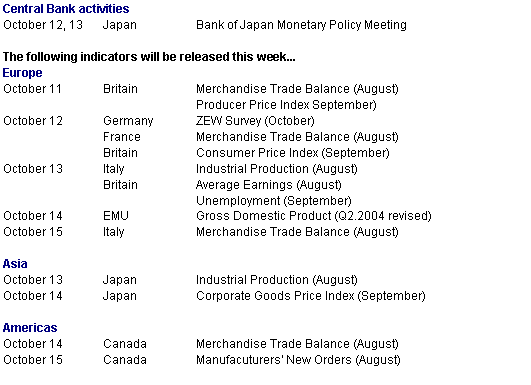Monday, October 11, 2004

Interest rates on hold
Three central banks met last week and all three - the Reserve Bank of Australia, Bank of England and the European Central Bank - left their interest rates unchanged at 5.25 percent, 4.75 percent and 2 percent respectively.

Reserve Bank of Australia
The Reserve Bank of Australia kept its key interest rate unchanged for the 10th month at 5.25 percent and prior to Saturday's general election. Evidence suggests that last year's rate increases have finally slowed the housing market where home prices have soared in the past three years while household debt climbed. Now, consumers are being more cautious, with gasoline prices going through the roof along with uncertainty about the upcoming election. The average price of gasoline was up 4.9 percent in August and has jumped 12.6 percent over the past six months. Despite this, inflation remains under control. Consumer prices were up 2.5 percent in the second quarter when compared with the same quarter in 2003 and remain within the RBA's inflation target range of 2 percent and 3 percent. The RBA doesn't release a statement explaining its decision when rates are kept unchanged.
European Central Bank
The European Central Bank left its key interest rate at 2 percent amid signs that record oil costs and rising unemployment are tempering the pace of economic growth. The interest rate has been 2 percent since June 2003. In his post-meeting press conference, ECB President Jean Claude Trichet said that the EMU growth outlook is subject to "a good deal of uncertainty," particularly as a result of higher energy costs. Oil prices above $50 a barrel, copper and aluminum futures at a nine-year high and a 9 percent unemployment rate continue to hamper the EMU's recovery. According to Trichet, consumer confidence is showing signs of improving but household spending does not yet point to an immediate strengthening of consumption growth. And if oil prices were to remain high or even increase further, it could dampen the strength of the recovery both inside and outside the euro area.
Bank of England
The Bank of England left its key interest rate unchanged at a three-year high of 4.75 percent as a drop in factory output and slower expansion in services indicated that the Bank's five rate increases since November are damping growth. The Bank of England last raised its interest rate in August and has the highest among the Group of Seven industrial nations. The Bank of England was the first of the world's three biggest central banks to raise interest rates in November, after economies including the U.S. and Germany went into recessions in 2001. Since then, the Federal Reserve has increased its target rate three times to 1.75 percent. Neither the ECB nor the Bank of Japan has raised rates in the past four years.
Global Markets
All bets are off when the week ends with the U.S. employment situation report. While Asia/Pacific investors won't have to deal with the disappointing report until Monday, those in Britain and Europe didn't have that option. Currency traders had their fingers on the sell button when employment growth was lower than analysts' forecasts. Equity traders were more equivocal, however. Pluses turned to minuses in Europe while in the Americas stocks were down even in Canada where a very strong employment gain should have buoyed more than just the Canadian dollar.
Equities began the quarter and the month rather exuberantly, but enthusiasm faded as the week progressed when crude oil price increases showed no sign of abating. Despite losing ground as the days wore on, 10 of 13 indexes followed here ended the week on the plus side. The Dow, Nasdaq and Bolsa lost ground on the week.
Crude oil prices continue to climb ever higher and "new records" are proclaimed almost daily. Jitters are focused on -
- climbing demand especially in China,
- the slower than expected pace of the resumption of production in the Gulf of Mexico oil refineries post hurricanes,
- the tricky situation in Nigeria,
- the continuing Russian production problems with Yukos,
- uncertainty about Venezuelan supplies and
- the usual potpourri of Middle East terrorist worries.
The price of oil vaulted over $53 a barrel Thursday after supplies from the Gulf of Mexico failed to recover in the aftermath of Hurricane Ivan. Production there is still down by about a third. Meanwhile, rebels threatening to disrupt oil exports from Nigeria agreed to a peace deal but oil workers in the country threatened strikes.

Global Stock Market Recap

Europe and Britain
The equity indexes in Europe and Britain began the month and quarter exuberantly, but investors quickly became cautious as crude oil prices climbed and a pharmaceutical company was forced to halt production of crucial flu vaccine. This combined with the earlier announcement that a major Merck drug for pain and arthritis was being removed from the market because of unfavorable side affects to put downward pressures on the indexes. Equity indexes were up Friday morning pre-U.S. employment data, but sank after the data disappointed. Despite the concerns, the FTSE, CAC and DAX managed to end trading for the week on the positive side thanks to the gains achieved on Monday and Tuesday.

The FTSE closed over the 4700 mark on Tuesday and Wednesday but then slipped just below that level at week's end. The FTSE began Friday in positive territory above the 4700 level, but lost ground on the disappointing U.S. data. It clawed its way back after investors reconsidered the pharmaceutical sector, deciding that it was still a fast growing sector despite the problems of the last several days.
Investors in European stocks sold technology companies such as Nokia after the employment report. The U.S. is Europe's largest export market and slower employment growth was interpreted to mean that more corporate profit margins are going to suffer as consumer demand weakens.
Asia/Pacific
Investors in the Asia/Pacific were in bed when the U.S. employment data were released. During the week, they had been more concerned with spiraling energy prices as new worries surfaced prior to the northern hemisphere's heating season. The projected high prices for heating oil in the U.S. is a concern for exporters fearful that consumers will cut back to pay for keeping themselves warm. On Friday, the Nikkei and Topix index dropped after a government report showed machinery orders rose less than expected, signaling a slowdown in demand for digital products. All six indexes tracked here were up on the week.

The Australian All Ordinaries hit new record highs during the week, closing on Thursday at 3710.5. Thus far, the index is up 11.8 percent in 2004 and is up 6.2 percent since August 16th.

Currencies
Commodity currencies such as the Australian and Canadian dollars have been climbing thanks to soaring commodity prices. The Australian dollar touched its highest level in three months after climbing for a fourth straight week thanks to record high commodity prices. For example, copper hit a 15-year high in New York while aluminum climbed to a nine-year high. Australia is the world's fourth-largest exporter of copper ore concentrate, and the biggest exporter of alumina, the material used to make aluminum. About two-thirds of exports, which make up a fifth of the economy, are commodities. Higher commodity prices boost the revenues and repatriated profits of Australia's biggest raw material exporters. For example, shares of BHP Billiton Ltd., the world's biggest mining company, have gained 22 percent so far this year. The Australian dollar was boosted by their strong employment report that showed a jump of 63,500 jobs in September, twice the expected 30,000.

Meanwhile, the Canadian dollar climbed to US$0.80 for the first time since March 29, 1993 after Canadian employment was up by twice as many workers as analysts expected while job growth in the U.S. slowed. As in Australia, a reason for the climbing Canadian dollar has to do with soaring commodity prices. The Bank of Canada's Commodity Price Index is up 19 percent this year. The Bank increased its interest rate by 25 basis points on September 8th for the first time in 17 months to 2.25 percent. And Governor David Dodge has said that the bank would need to lift its interest rate further. Higher interest rates can boost the currency's appeal as international investors buy Canadian debt securities. But at the same time, a rising Canadian dollar can curb the appeal of Canadian exports, which become more expensive.
Both the euro and yen were up on the week. Both currencies had lost ground earlier in the week but rebounded on Friday after the dismal U.S. employment report. The dollar dropped against the yen by the most since December 2002 and tumbled versus the euro after employment failed to meet expectations by a significant margin. The U.S. dollar also weakened against the British pound and Swiss franc.

Indicator scoreboard
EMU - August real seasonally adjusted retail sales dropped 1.3 percent and were down 0.4 percent when compared with last year. Sales of food, drink and tobacco sank 1.3 percent while non-food product sales were down 1 percent.

August producer price index was up 0.4 percent and 3.1 percent when compared with last year. The increase was largely due to the 1.4 percent increase in energy prices. Excluding energy, the PPI was up 0.1 percent and 2.3 percent on the year.

August seasonally adjusted unemployment rate remained at 9 percent for the fifth month. Of the nine EMU countries reporting data, unemployment was unchanged in eight and was down in one. Spain (11 percent) continued to show the highest unemployment rate followed by Germany (9.9 percent), France (9.6 percent) and Finland (9.0 percent). Luxembourg registered the lowest rate at 4.3 percent.

September seasonally adjusted service sector business activity index recorded a reading of 53.3 signaling growth for the fifteenth successive month. However, the index dropped for the second month in a row, down from 54.5 in August, to register the weakest monthly expansion in thirteen months. Services activity was up at a slower pace in all of the EMU's four largest economies, but rates of growth varied markedly. Italy recorded the fastest pace of increase for the fourth month running, despite growth slowing for the third month in a row to hit a five-month low. Germany meanwhile recorded the weakest increase (as has been the case over the past two-and-a-half years), with the pace of growth slipping for the second consecutive month to reach a thirteen-month low.

Germany - September seasonally adjusted unemployment rate edged up to 10.7 from 10.6 in August. In west Germany, the rate remained at 8.6 but in the east in inched up to 18.7 percent from 18.6 percent in August. The number of unemployed was up by 27,000 for pan-Germany with 12,000 of the increase in the west and 15,000 in the east.

August real seasonally adjusted manufacturing orders sank 1.5 percent but were up 6.0 percent when compared with August of last year. Foreign orders plummeted 2.1 percent while domestic orders dropped 1.0 percent. Investment goods orders sank 2.1 percent after soaring 3.9 percent in July, mostly due to declining foreign demand. Consumer goods orders plummeted by 5.4 percent. Again, foreign demand was the culprit although domestic demand also contributed to the decline. West German orders were down 1.5 percent while orders in the east plunged 2.5 percent.

August seasonally adjusted industrial production sank 1.0 percent but was up 3.7 percent when compared with last year. Most categories were down. Construction output plummeted 2.2 percent while energy plunged 2.7 percent. Manufacturing output was down 0.7 percent, erasing about half of July's increase. Within manufacturing, consumer durable goods production sank 9.6 percent while nondurables dropped 0.7 percent.

August seasonally adjusted merchandise trade surplus eased to �11.9 billion from �12.7 billion in July. Exports dropped 1.4 percent while imports edged down 0.1 percent.
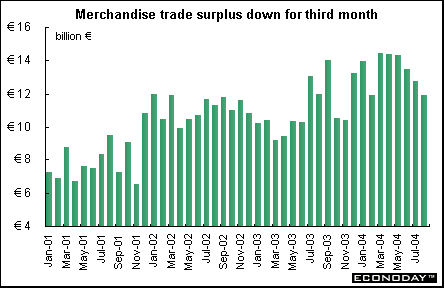
Britain - August industrial production dropped 0.8 percent and was down 0.1 percent when compared with last year. Manufacturing output was down 0.8 percent but was up 0.4 percent on the year. Output dropped in ten of thirteen sectors with the largest declines in transport equipment (down 3.8 percent), electrical & optical equipment (down 2.7 percent), and machinery & equipment (down 3.3 percent). The only significant increase occurred in chemicals & man-made fibers (up 4.3 percent).

September Halifax house price index was up 1.4 percent and 19.9 percent when compared with last year. For the three months ending in September, prices were up 20.5 percent when compared with the same three months a year ago. The average house prices rose to Stg162,911 from Stg160,565 in August.
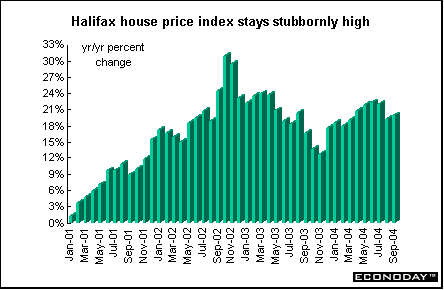
Asia
Australia - September employment jumped by 63,500 jobs and the unemployment rate eased down to 5.6 percent from 5.7 percent in August. Full-time employment increased by 19,100 while part-time jobs jumped by 44,400. About 9.7 million people are employed in Australia, which has a population of 20 million. The jobless rate compares with 5.4 percent in the U.S. in August and 4.8 percent in Japan.
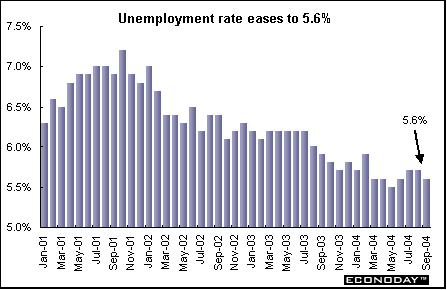
Americas
Canada - September employment was up by 43,200 jobs. The unemployment rate eased to 7.1 percent from 7.2 percent in the previous month. All of the gain was in full-time jobs. Full-time employment jumped by 72,000 jobs while part-time employment dropped by 28,600. Manufacturing jobs declined by 21,200 while the service sector gained 64,400 jobs.
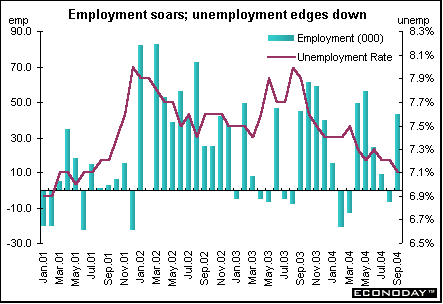
Bottom line
Last week's plethora of data continued to show that growth has eased almost everywhere. From an easing of services growth to downright disappointing British industrial production data and U.S. employment data, the evidence was abundant. While the impact of oil prices has yet to add to inflationary pressures, it surely is having an impact on consumer spending, especially since employment and income gains remain low especially in Europe.
The story is different in Australia. The creation of twice as many jobs as economists expected should be a boost for Prime Minister John Howard ahead of the October 9th general election in Australia. Job creation and interest rates are key election issues for Howard as he seeks to win a fourth term. Since Howard came to power in 1996, almost 1.4 million jobs have been created and the jobless rate has fallen from 8.2 percent to the current 5.6 percent.
Looking Ahead: October 11 through October 15 2004
